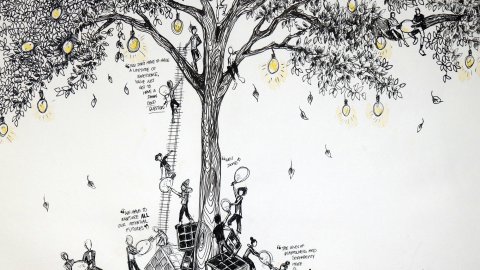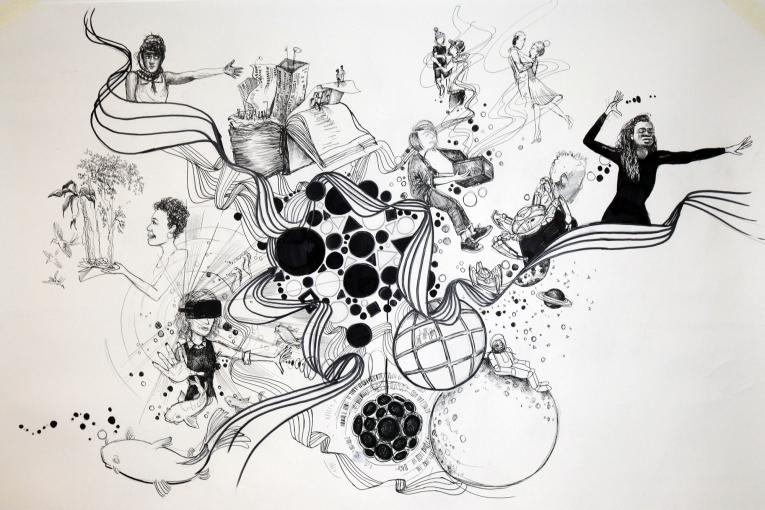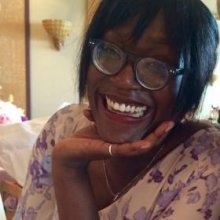
Zahra Ash-Harper Inclusion Producer
on Mon 16 Oct 2017What is the role of a cultural organisation during Black History Month?
Posted on Mon 16 Oct 2017
Zahra Ash-Harper, Watershed Producer, reflects on her year at Watershed working on inclusion and the practical steps we are making, plus asks wider questions about Black History Month and the role of cultural organisations during this time...
As a Black woman and a Producer I have seen and heard worrying behaviours in the culture sector, but have retained an impatient and burning desire for progress. For the past 15 months I have worked at Watershed with a focus on developing our approach to inclusion. This has meant engaging with the wider questions being asked by and of, our creative industries. I find myself pleased to say in 2017 that “I’m beginning to hear music to my ears” as the 'white noise’ of anxiety which previously accompained conversations on how to tackle increasing 'representative inclusion' in the arts, shifts to a pleasant background noise of constructively critical but confident chatter.
The rumblings of change are coming from many directions, and can be seen in Arts Council England’s Creative Case for Diversity, to MeWe360 Paper on Black Arts Funding, to conferences like No Boundaries, Awkward Bastards and beyond. As a sector, we are making definitive pledges and stating our values in reference to boosting inclusion and representation.
Importantly there is also a healthy acceptance across the sector that no one has reached a conclusive solution: There is a refreshing refusal to bend and fold and accept a convenient conveyor belt of rhetoric, propaganda and legislative tokenism.
All of a sudden, some of those with power accept that ‘one size will not fit all’.
So why am I writing this now? Because it is Black History Month across the UK, and I wanted to consider the role of cultural organisations during this time.
BHM is a time for all organisations, but particularly those involved in arts and culture, to reflect and share thinking. It is a moment to stop and assess how best to begin again; to recognise how hard a year of activism has felt; to re-charge for another year(s) of challenging organisations to be inclusive in a way that reflects the demographics of the cities they operate in.
A joyful, celebratory - and hard - job
To speak personally about the cost and benefits of thinking and working in ‘representative inclusion’ at Watershed - it is a job that is joyful, celebratory and hard at times.
First, the bits that are hard:
Reflecting and acting objectively around issues that trigger recollections of my own career struggles is exhausting. The insecurity is doubled by knowing the cost of ‘dropping the ball’ or failing to ‘send the lift back down’ to those whose hopes and dreams are hard won and whom I believe in.
Often I find myself in the midst of emotionally and politically charged discussions, which feel personally and professionally risky. But when the job is done effectively, it necessarily sees me critique and disrupt the ‘status quo’ within the organisation and industry I work for whilst reassuring where possible the understandable scepticism of a community of Black people who have felt alienated or scarred by past experiences.
I repeat, this work is super hard. It is frightening to live in a present where we do not know what the differences we seek will actually become manifest.
However the JOYFUL includes…
The simple existence of my role in Watershed’s Pervasive Media Studio, which has a focus on how we can best support and retain BAME creatives in our growing community of residents. The Studio is open about its acceptance that the demographics of the resident community did not reflect those of the city. Happily, within a year the Studio has seen a 107% increase in the number of BAME residents, which has brought us within 1% of the Bristol population demographics (our target baseline).
These results require an openness to change: I was hired into a team with the healthy opinion that we all need to be ready to be challenged and do things differently in order to play our part in tackling systemic issues. The Watershed team believes that BAME under-representation in the arts and creative technology sector must be challenged - with good will, honesty AND resources.
Our progress so far inspires me to be optimistic - I’m incredibly proud of how quickly our new BAME residents have settled into the Studio community. It’s been a privilege to join each personality on their project journey, see them establish new relationships and carve out the space needed to get their projects thriving. Edson Burton, Watershed Artist in Residence 2016, says of his time at the Studio: “I have been blessed with commissioned work in the past but to work on a passion project, one which I know will make a unique contribution to discourses around theatre, diversity, and Afrofuturism, is a dream come true.”
Despite these clear steps forward, one of the major challenges I continue to battle with as a Watershed Producer is knowing when and how it is best to share the progress we are seeing with wider audiences, and particularly with Black audiences. Sharing and being hopeful is part of who I am and an essential way of contributing to the value of this work within the arts sector.
Nonetheless being from the Black community myself, I feel honour-bound to share progress with a respectful recognition of what (I would assert) has been a long established culture of white representation dominating the creative industries. This, I believe, has come at the expense and erasure of many artists and audiences of colour, as well as a richer social understanding of the communities and cultures they represent.
What Watershed is doing...
Watershed is trying various practical ways of driving inclusion including the formation of an inclusion ‘working group’ made up of representatives from all teams (including Executive and Board). At this moment the group has a particular focus on human resources and recruitment - but also thinks about our relationships with community partners, our communications channels, and how we share our work and inspire other organisations to be better and more aware of inclusion issues.
Within the Studio, the whole team are building relationships with BAME creatives in Bristol, and supporting residents in thinking about inclusion within their own projects. Better representation in the studio community is helping us reach and build trust with wider audiences. As Studio resident Onallee shared: “Being in the Studio has brought me more confidence that my practice can be changed and developed into new areas and removed that feeling of being alone shouting in the dark”. Bringing new creatives from BAME communities into the Studio has meant we can support projects that reach the BAME communities in new, respectful and relevant ways.
With this in mind we have spent the last year developing a series of micro residencies which offer the opportunity for creative practitioners to dive into a type of collaborative practice which may currently be at the edges of their work. It is a chance to play, be inspired and reflective. To breathe and explore (without pressure of delivering specific outcomes), to discover the role digital technologies might have in their practice. Most importantly it is a chance to learn more about the Studio and the creative technology community of Bristol, without the need to learn the ‘right language’ or navigate their way through a formal application process.
Recently a colleague - Nikesh Shukla - shared a quote by Junot Diaz with the organisation which we have taken to heart. He said: “You know, vampires have no reflections in a mirror?... if you want to make a human being into a monster, deny them, at the cultural level, any reflection of themselves”
This has inspired Watershed to revisit the Studio as a physical space and considering how we might communicate our changing demographic and networks, it has stimulated us to begin thinking more critically about how we welcome new people from a variety of backgrounds into the space and make these people feel at home while they are here with us.

The first step has been to reimagine our wall space by commissioning three large murals (one of which is pictured above) by Rife Magazine alumna Jasmine Thompson, the images lead the way into the space with warm words, memories and faces that reflect the life and legacy that fills the space on a daily basis. It is critical that the environment develops alongside and supports representative inclusion of people, practice and projects now finding their way to us. Relatively new resident Lawrence Hoo said: “seeing my project partner Mike Jenkins and I included in the Studio mural gave me a feeling of belonging and acceptance. It made me feel part of a new family.”
Outside of this activity from this year, which has made changes but certainly has a way to go. It's a long journey we are all on, and staying relevant and keeping track of a shifting true north is essential. I lean on the following processes to guide my thoughts and actions, I try and speak from a personal perspective about my experience, be brave but humble in my approach and ask myself the question which keeps me moving forward: ‘what do the artists I work with have to say about the changes we are experiencing and how many new people from the black community have I shared the work of the studio with this week!?’ Reminding myself of this removes the expectation that I can speak as an authority across multifaceted issues relating to the Black community and inclusion in the arts.
Questions and challenges around Black History Month
Which brings me back to...
Black History Month, and the specific and challenging questions it presents for Watershed and the key question we have to reflect around our specific role and responsibilities: Should we focus on one month, when we are trying to encourage an open and accessible venue all year round?
Feedback from the community of Black creatives that we regularly collaborate with suggests BHM heralds a very busy time for artists of colour, with lots of commissioning opportunities that may not normally arise. So is our job during BHM to get out of the way? Or does this risk seeming unconcerned for our audience's experience of BHM?
Black History Month invites many questions from across the creative community and is never straightforward. I have collected some of them here:
- This month has become very stressful with so much going on, is it an enjoyable process of making and delivering work into this timeframe?
- What happens in terms of commissioning with these organisations the rest of the year?
- Is the plan to phase out BHM as education, businesses, arts and culture represent a variety of voices appropriately?
- Should BHM be repositioned as a black cultural festival rather than a ‘month’?
- Does BHM send the right message, or does it suggest we have given up on challenging the dominant cultures to consistently make space for other narratives and access to Black histories easily accessible?
- Is it possible to deliver qualitative black historical knowledge or black contemporary concerns within Black History Month?
- What is the black in Black History Month? Is the default Black, everyone who is not white? Originally it was of African descent and now people are also talking about Diversity month?
- Is Bristol behind in terms of talking about Black narratives - Bristol’s narrative is annoyingly hardwired into slavery and music?
- How do we inject more varied and indigenous creative processes into BHM?
- Is BHM to educate white audiences or a time for celebration and reflection of Black people on their own culture?
- How can we subvert the institution of BHM by representing wider/migrant/newer black communities?
And finally, back to me!
During Black History Month, I believe it is the role of the arts organisations to reflect inwardly on their intentions. To remember those who pioneered a space for us - who fought for our ability to legitimately work in the creative sector.
To share a quote Clare Reddington, our Creative Director often refers to, first coined by Rebecca Solnit: “hope locates itself in the premises that we don’t know what will happen and that in the spaciousness of uncertainty is room to act”. I love this quote because it hints at the vulnerability and excitement wrapped up in stepping up to our more courageous ambitions and keeps me open to embracing risk as par for the course.
More than anything, it’s a time for the people that have toiled to bring inclusion forward throughout the year to be kind to ourselves and each other.
Here are some pressing questions for me in the next year:
- How do we sustain this progress?
- How do I join up with other inclusion professionals in the arts?
- How do we raise the awareness of BAME creatives and projects within BAME communities?
But we really want to hear from you! How do you feel about what we are trying to do? What do you think we should be doing? And what should we ask ourselves in time for the next Black History Month? Tweet us @wshed using #HackBHM or comment below....

